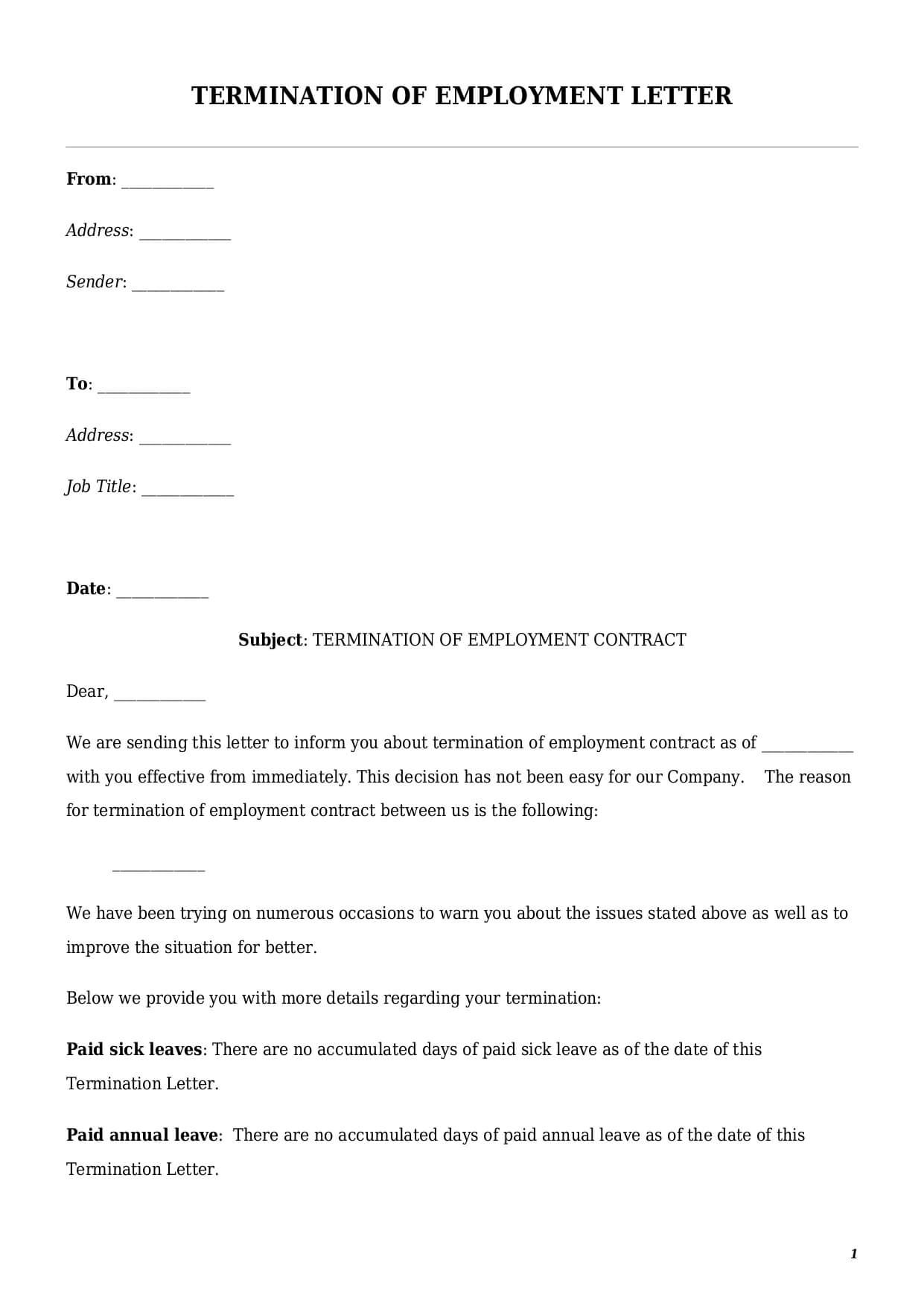Termination of Employment Letter
Reviews


What is a termination of employment letter?
A termination of employment letter, also known as a letter of termination of employment, is a formal letter used to inform the worker about termination of employment. The letter is a company’s official HR document as it confirms the fact of the termination of employment relations.
The termination of employment letter is not a simple document, as it covers the following important aspects:
- effective date for termination (i.e., the date of a worker’s last working day);
- reasons for termination (e.g., redundancy, poor work performance);
- protection of confidential information (i.e., a worker can be asked to sign a non-disclosure agreement with a former employer);
- non-compete clause (i.e., a worker might be asked to limit their competition against the former employer after termination);
- 401k distribution after termination of employment;
- repayment of severance pay and bonuses (if applicable); and
- return of company’s property (e.g., laptops, uniforms, mobile phones, etc.).
A well-drafted termination of employment letter serves a dual purpose. Firstly, it is an official way to communicate to the worker about termination of employment. Secondly, it allows the employer to provide clear evidence and reasons for termination of employment. If any legal dispute occurs in the future, a termination of employment letter serves as a powerful tool in solving a dispute.
The termination of employment letter can be used by small and medium businesses, start-ups, and partnerships.
It is worth remembering that a termination of employment letter applies only to employment contracts. A termination of employment letter cannot be sent to an independent contractor or freelancer.
Additionally, this letter can be used in various contexts, including immediate dismissal, voluntary termination of employment, or the ending of a termination of employment contract (for example, when an employment agreement has a set end date or conditions for termination).
Types of Termination of Employment
Types of termination of employment vary depending on the reason for termination, as well as who acts as initiator for termination. Each type can influence the content of the letter of termination of employment significantly.
The termination of employment can be of two main types:
- Voluntary termination of employment: When the employee chooses to resign. This may happen for various reasons, including retirement, another job, personal reasons, etc.
- Involuntary termination: When the employer ends the employment.
In its turn, an involuntary termination can differ depending on the actual reasons causing the termination of employment:
- redundancy or layoffs (e.g., this may happen due to a hard economic position within the company or due to the implementation of new technologies that make certain positions within the company inefficient);
- end of fixed-term employment contract;
- worker’s poor performance (e.g., inability to deliver the assigned tasks on time, insubordination, etc.);
- worker’s discipline at the workplace (e.g., a worker might be accused of bullying or harassment) and so on.
How to Draft a Termination of Employment Letter?
Drafting a termination of employment letter from scratch might be daunting. Therefore, we made a short list of tips that might help you to do that:
Use professional language
When drafting a termination of employment letter, it is essential to put all emotions aside and focus on facts only. Make the letter sound neutral and professional. The letter of termination of employment is not only about ending the employment relations. It also helps to communicate valuable feedback to a former worker so that he or she can improve in the future.
Include essential details
The letter of termination of employment should contain:
- Employee’s name and position;
- Effective date of termination
- Reason for termination (optional, but often recommended)
- Information about final pay or final paycheck (including all accumulated bonuses, severance, etc.)
Think about organizational process
If a worker has access to the company’s property, think about how that property should be returned.
The termination of employment has a direct effect on the 401k account. Therefore, it is also important to address 401k distribution after termination of employment, health insurance continuation, and other things.
Think about legal requirements
If a worker holds a senior position within your company, it might be reasonable to sign a non-compete agreement. By doing so, you can protect your company against potential competition from ex-workers.
Make termination smooth
Do not forget to include additional contact details like a phone or email address that the worker can use to contact you to ask questions or raise some concerns.
It is a good business practice to organize a so-called “exit interview.” By doing so, you can ensure that a worker leaves on good terms.
Table of content
Frequently Asked Questions (FAQ)
-
1. How to write a letter of termination of employment?
The termination of employment letter template should include the following mandatory elements:
– termination of employment date;
– clear and precise reasons for termination;
– full name and job title of an employee;
– the amount of the final paycheck (including severance, bonuses, etc.);
– the letter should be dated and signed by the employer.
-
2. In which cases can I use a termination letter to employee for unacceptable behaviour?
This type of termination letter template could be used in either of the following circumstances:
– harassing or bullying other employees;
– constant violation of the company’s internal rules and procedures;
– poor working performance (e.g., inability to meet deadlines);
– constant discipline issues (e.g., lateness to work) and so on.

Looking for something Different?
Start typing to find out our collection of legal documents and contract templates
